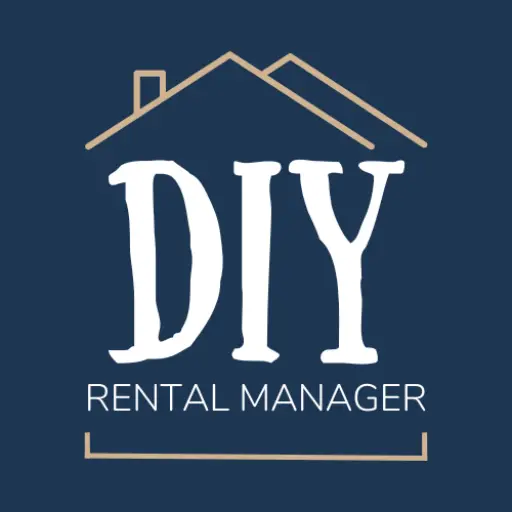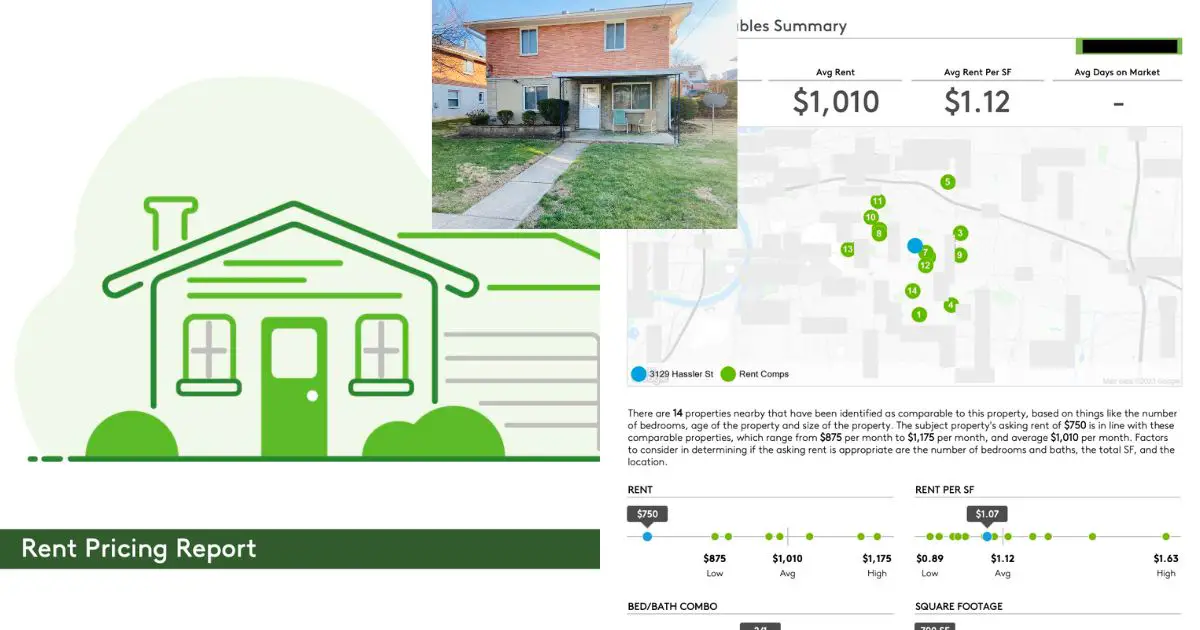Figuring out the perfect rent price to charge for your rental property is half art and half science. You want to find that sweet spot that gets you the most amount of money while also getting your rental property filled as fast as possible.
Of course, that is easier said than done, though. So, how do you figure out how much to charge for rent?
The best way to decide on what to charge for a rental property is to gather the property specs (sq ft, bed/bath count, etc), research current listings and their offerings, use rental comparison reports to find the median rental price and monitor the performance of the listing while it’s published.
With those main points in mind, I’ll cover everything you need to know to price your rental property below.
Let’s dive in!
Quick Navigation
- Gather The Property Specs (Square Footage, Bedroom/Bathroom Count, Etc)
- Search On The Platforms You Plan To Publish On
- Use Rental Comparison Reports
- Choose A Rental Price Slightly Below The Median Price For A Faster Turnaround
- Monitor The Performance Of The Rental Listing While It’s Published
- Final Thoughts
- Related Content
1. Gather The Property Specs (Square Footage, Bedroom/Bathroom Count, Etc)
First, we need to gather some information on the property you will be renting so we can do some research on the current rental market.
The main property specifications you will need include:
- Property type (townhome/duplex, single-family house, apartment)
- # of bedrooms
- # of bathrooms
- Square footage of home
- Zip code
- Screening requirements (including pet policy and smoking policy)
Once you have these property specs, you’ll be able to find other rentals available on the market today that are going to be your direct competition. You can use the listings for these comparable rentals to decide on what you can price your rental for.
For example, for the last rental that we listed on the market, the property specifications looked like the following:
- Townhome/duplex
- 2 bedrooms
- 1 bathroom
- 1300 square foot home
- Zip code
- Screening requirements:
- Household income must be 3x the rent
- No evictions ever
- No felonies or violent crimes from the last 8 years
- A minimum credit score of 600 with no collections
- Cats and dogs allowed
- Non-smoking
2. Search On The Platforms You Plan To Publish On
Next, we need to search on the platforms that we plan on publishing the listing so that we can review the listings from our competition.
We like to use Zillow.com and Apartments.com because the majority of renters in our market look on both of these platforms. If most renters use Craigslist (or another listing platform) in your local market to find a rental, then you need to review the competition on those platforms.
As you search on Zillow (or whichever listing platform you choose), filter the results based on the type of home, the number of bedrooms, and the number of bathrooms that your rental has. Ignore the other property specs for now. We just want to see what properties are available to potential tenants at this broad level.
As you search, make a few notes on the following:
- The lowest rental price for the number of bedrooms and bathrooms your rental offers
- The highest rental price for the number of bedrooms and bathrooms your rental offers
- The median rental price for the number of bedrooms and bathrooms your rental offers (the number that keeps consistently popping up across several listings)
- The amenities you see offered most frequently on listings (in-unit washer-dryer hookups, pets allowed, water paid for by the owner, etc)
- The screening requirements other properties have (credit score, background check, etc)
The three rental prices you write down (the highest, median, and lowest prices) are the most helpful numbers you’ll need to determine your rental price initially because these are the direct competition you’ll be competing against to find the best tenant.
Also, pay attention to the amenities these listings offer and their screening requirements, and select the ones that are closest to what you are offering. (Or modify your offer to be closer to theirs so you can be comparable.)
In the next step, I’ll explain how to find even better rent comps than just this basic search. But for now, getting a basic understanding of what’s out there will help you start to narrow down on a rent price.
3. Use Rental Comparison Reports
Now it’s time to check out some rental comps to help you get a better understanding of what price properties have actually rented at recently.
How To Find Rental Comps
Whatever management software you are using probably has a Rental Comparison Report that you can use to choose a rental price. If you aren’t currently using management software, then I highly recommend you check out Apartments.com’s Rental Manager Tools.
Not only can you easily list your property and manage your tenants through this website, but you can also get a free Rent Comp Report.
Apartments.com’s Rent Pricing Report is my all-time favorite rental comparison report to use because it pulls back the top 10 similar properties around your rental that rented within the last year. These aren’t homes that are on the market currently, they are homes that recently got taken off the market because they successfully found renters.
This report also gives you the exact addresses of these properties so you can pull the listings up for more information to see how your listing compares. The report also gives you an estimate of how long the properties have been sitting on the market, so you can know what to expect for the timeline.
Note: When you add a new property to Apartments.com, it takes 24 hours before the Rent Pricing Report can generate the rental comps. It can be frustrating to wait a day, so I recommend getting the property created with the initial rent price you figured out through your own research from the first step as soon as possible. That way, you can get access to this report.
I also recommend checking Zillow’s free Rent Zestimate Report to see what is available currently and what was just rented on that platform as well. Zillow’s Rental Manager Tools offer a much more accurate rent estimate than the Zestimate score that you see on the listing page because it also pulls back actual properties that are currently listed and that have just been filled by a tenant along with their addresses so you can do more sleuthing.
How We Use Apartments.com’s Rent Pricing Report To Choose A Rent Price
Once we can view the Rent Pricing Report, we review the chart with the lowest price, average price, and highest price.
We also like to look at the properties that are less than 1 mile away from our rental (preferably within .5 miles or less) and look at the rental price they got. Pulling up their actual listing also helps us compare our offer and the condition of our home to theirs.
Finally, we review the section of the report that discusses the market conditions. If the Days On Market stat is less than 30 days, then the market is considered balanced or landlord-favored, so we usually choose a price that is much closer to the average.
However, if the Days On Market stat is over 30 days, then the market is considered renter-favored, so we usually choose a price that is much closer to the lowest price to fill the home faster.
Then, we do the same thing with Zillow’s rental comparison tool to get as much information on the current market as we can before making a decision.
4. Choose A Rental Price Slightly Below The Median Price For A Faster Turnaround
As you review the rental comp reports, it’s good to keep a few things in mind.
If your unit is fully renovated and completely brand new, you can charge just above the median price because renters love brand new – it means less maintenance and many of them don’t get to live in as nice of a place as a freshly renovated unit.
However, going above or at the median price can make the property sit on the market for longer because many tenants want the nicest home for the cheapest price they can get that has the number of bedrooms they currently need.
If you want to fill a rental unit faster, update the look of the home while also pricing it slightly below the median price you found in the rental comp reports. This combination will get you the most amount of qualified applicants applying, so you can be very selective and get the best tenant out there currently.
For an updated unit, that often means new LVP flooring, a fresh coat of paint on the walls, cabinets/appliances/shower fixtures that are in good condition/on the newer side, and electronic deadbolts installed on the exterior doors. This does not have to mean everything has been replaced and is brand new or is the modern color scheme, it just can’t be falling apart/worn-looking when the tenant moves in.
The best rental price to choose is one that is $25-$75 below the median rental price currently available on the market. This pricing strategy will get the most qualified applicants to apply to your rental property in the shortest amount of time. The more modern your rental property is, the closer to the median rental price you can charge.
Going back to our example, when we were reviewing the rental comp from Apartments.com, we knew our home was much bigger than the average rental on the market (ours was 1300 sq ft while many of the others were only 800 sq ft). We also knew our property was in good condition (although not fully updated/modernized), so we chose a price ($1,000.00) that was just below the average price in the report ($1,010.00).
As a few weeks went by, we ended up dropping the price to $975.00. That price started bringing in qualified applicants. Looking back, if we had just started the rent price at $975.00, we probably would have filled the home faster because we would have been offering a nice home at a competitive price.
Ultimately, finding a great tenant is more important than finding a tenant that will pay $25.00 more in rent each month. And since it took us longer to fill the home (probably 2 weeks longer than necessary), we lost out on half a month’s rent more than we needed to.
Another time we had a vacant unit, we fully renovated the home and asked for a rent price of $850.00 in an area where the average rent price was $900.00. In that home, we found a qualified tenant within 1-week during a time when the Days On Market stat was closer to 25 days.
It really does make a difference in time when you price the rental below the average or median price, and time is money in the rental industry.
Once you have your price, your professional-looking photos taken, and your irresistible listing description crafted, you can publish your listing!
5. Monitor The Performance Of The Rental Listing While It’s Published
Finally, while we have our listing published, we continue to monitor the prices of other rentals and how long they are staying on the market before disappearing.
This is where we do a combination of manually checking what’s currently available on the platforms (as we explained in step 2) and checking the Time On Market stat in the Apartments.com Rental Pricing Report to see how quickly units are being filled (as we did in step 4).
In a landlord-favored market (rentals being filled in less than 30 days), you should be able to quickly see if your price is on point or if it’s too high. If you are consistently getting new inquiries every day or every other day, your price is probably in a good spot. Though, if a couple of days go by between inquiries, it might be a sign that your price is too high, and it is time to lower it.
In a renter-favored market (rentals being filled after 30 days of sitting on the market), you are going to have to be more competitive with your offer. This might mean choosing a rental price on the lower end of the rental comp reports. And if the Time On Market is over 50-60 days, potentially offering a discount on the first month or two of rent. The amount of concessions you might have to give will depend on what other rentals available are offering.
In this renter-favored market, if you are consistently getting a few new inquiries each week, your price is probably in a good spot. Though, if a full week goes by and no one has inquired, it might be a sign that your price is too high, and it is time to lower it.
As each 1-2 weeks goes by that we don’t find a qualified tenant, we typically will drop the price by $25-$50 to see how that affects the listing’s performance. It’s a fine line between waiting too long before dropping the price so the property sits on the market too long and dropping the price too soon so you don’t get as much money as you could have.
So we like to use the Time On Market stat and the number of inquiries we are consistently getting to help us decide how fast to drop the price. And we like to monitor how the other listings are doing over this time period. If some of them are getting filled quicker than ours, we review their listing to see what they are offering that we are not.
Final Thoughts
That’s it! By now, you have a rental price chosen and a solid plan on when to lower the price if you aren’t getting the type of applicant you want. Now, all that’s left to do is reply to inquiries on the property and screen the applications that come in (employment/income, credit history, background history, and rental history)!
We’ve found that by taking time to research the market first, we choose a price that lets us maximize our profits while also filling the home quickly with a great tenant. This ultimately helps us find better tenants that help us self-manage our rental properties for only 5-10 hours a month because they pay on time and take care of the property.
I hope you find this article useful and that it helps you attract great tenants who would love to live in your rental home!
Catch you in my next post!
Related Content
Check out my recommended tools, templates, and resources to free up your time from constantly working on and worrying about your rental properties. My husband and I use these tools to self-manage 18 rental units (and counting) for only 5-10 hours a month.
Keep in mind that most of these items are either free or reasonably priced for the amount of value that they provide. My goal on this page is to recommend tools, templates, and resources that we use daily and wish we had known about at the beginning of our landlord journey. Since implementing them, they’ve saved us countless hours and tons of headaches.
Finding good tenants for a rental property is arguably one of the most essential tasks that a self-managing landlord must accomplish. You’re searching for a high-quality tenant that will pay on time, take care of the property, and be easy to communicate with all while trying to get the most amount of rent and filling the vacant unit as quickly as possible.
That’s no small feat! So, how can you find good tenants for your rental property?


By Christine
Christine is a blogger and real estate investor/property manager who self-manages 18 rental units (and counting) alongside her husband, Adam. Although she successfully automates the management of her rentals and pockets the property management fee now, her path to success was not easy.
Go here to read her story, “From An Overwhelmed First-Time Landlord To A Pro Investor Self-Managing 18 Rentals On Less Than 10 Hours Per Month“.
Recent Posts
How To Reject A Tenant Application (With Examples!)
When you start to accept applications for your rental property, you’ll inevitably get some applications that do not meet your minimum screening standards (even if you list them in the listing, some people just don’t read or don’t care). When this happens, you’ll have to carefully review the application and send back a Tenant Application…
How To Write A New Tenant Welcome Letter For Your Rental Property
When we have found a new tenant that we are ready to sign a lease with, we want to start the new relationship off on the best terms possible. In order to do that, we need to ensure that they are familiar with the most important details of the lease. We do this by providing…
Ultimate Guide To Collecting Rent And Charging Late Fees As A Landlord (Easy System!)
Collecting rent from tenants is one of the most time-consuming (and emotionally charged) parts of being a landlord. Not only will you get every excuse under the sun about why rent will be late this month (again), but you will also miss out on opportunities to collect extra income and increase rent over time if…





